- info@wildlifeanimalcontrol.com
Call us for help in your town
Wildlife Control Education
How to Get Rid of Beavers
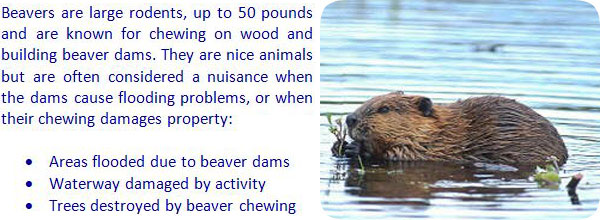
It is my goal to educate the public about beavers and other wildlife, and
provide tips for safe, effective, and responsible wildlife removal.
HUMANE HINTS: In some cases, you don't need to remove beavers at all - just leave them alone! You can fence around tree areas you don't want beavers chewing,
or apply Thiram repellent to trees. Install a beaver drain pipe to lower water levels when there is a beaver dam. NEVER attempt to poison beavers. There are live-catch traps for beavers, as opposed to lethal body grip
traps and snares. Read below for how-to hints.
Summary of Step-By-Step Instructions:
1) Inspect the situation to determine if trapping is necessary.
2) If you choose to use a clamshell live trap like the Hancock or Bailey designs, set it in a high traffic area, near a gnawed tree or beaver dam.
3) If you choose to use a lethal body-grip connibear trap, use a 330 size, and mount it over a beaver lodge entry hole.
4) If you choose to use a snare slide set... set it correctly - it's too complex to explain here.
5) I'll be honest here - there's no realistic way for a homeowner to trap and remove a beaver safely. These traps are difficult to set, and dangerous. If you must remove a beaver yourself, you may want to shoot it, as much as I don't like to offer that advice. But better yet, hire an experienced pro to help you.
Need beaver removal in your hometown? We service over 500 USA locations! Click here to hire us in your town and check prices - updated for year 2020.
Beavers are the kings of the North American and Eurasian semi-aquatic rodents. Beavers weigh over 60 pounds once they are full grown and are rarely messed with by other animals. Beavers construct dams out of logs, trees, leaves and mud that are very effective at stopping up water flow in a small stream or pond. Their dens are a part of this dam and can only be accessed by underwater entrances. Beavers live in family units, much like a human family and there will be several family units in a single area. Beavers are not dangerous creatures, but they can be territorial of their dam, their dens and their young.
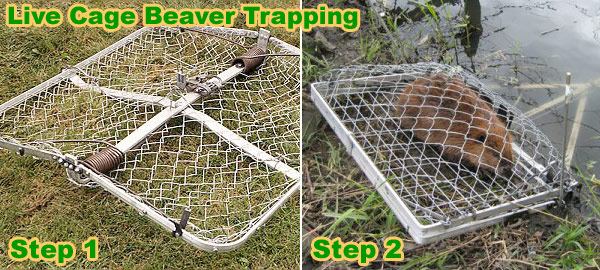
How to Get Rid of Beavers - Beavers are not usually considered nuisances because they are essential parts of our ecosystem. While building dams and felling trees may be annoying to us, this is an important function for new growth in wooded areas and water flow for aquatic life. However, it is because of these traits, that they are considered pests. Beavers cut down a lot of trees for food and for their dams which can make your property unattractive and cost you money.
Beavers can also disrupt the flow of lakes, rivers, streams, etc. that may flood certain areas of your property or disrupt the flow of drinking water. Another problem with beavers is that they carry diseases. Beavers carry diseases like rabies which they can pass by biting your pets, but this is not an issue usually. What is really dangerous about beavers is that they can give you Giardia which is no fun, and also carry parasites that can cause blindness, lymph gland problems and liver and lung failure. If you have beavers that you absolutely must get rid of, then you can follow these suggestions.
- Beavers are considered a vulnerable species in many parts of the world and it may be illegal for you to try to kill them or get rid of them, especially if there are newborn beavers in the dam. There are special ways that you must remove them off of a property or a lake, which is best left up to the experts. Calling animal control, the humane society or a pest removal service will be your best bet in getting rid of beavers.
- The best way to ensure that you do not have a beaver problem is to prevent them. You can prevent beavers from living next to you by building drainage systems to skirt past the beaver’s dam. You can also put up wire mesh fences around the base of trees to prevent the beavers from gnawing them down.
Read my info about how to keep beavers away - prevention techniques.
- There are also traps that are especially designed to capture beavers.
However, these traps can be expensive and if you are not sure what you are
doing, the beaver can get away or you can trap another animal that you did not
intend to catch. Beavers are extremely intelligent critters and once they figure
out that you are trying to capture them, they won’t go anywhere near the traps
you set. You just blew your money and still have a beaver problem. Again, it is
easier and more effective to call an expert to deal with the capture and
removal. Read about beaver trapping - analysis and methods for how to trap, bait, etc.
- There are rumors that there are certain scents can repel or scare beavers away, but many experts say it doesn’t work. These scents include things like predator urine (coyote, fox, king snake), ammonia rags, mothballs or pepper sprays. You can try using these, but they most likely will not work on getting rid of the beavers.
More in-detail how-to beaver removal articles:
Information about how to kill a beaver - with poison or other methods.
Information about how to catch a beaver - remove one stuck in the house.
Information about beaver repellent - analysis of types and effectiveness.
Beaver Information & Facts
Beaver Appearance: The beaver is large rodent with webbed hind feet and a hairless, paddle-like tail. Beavers are a variety of brown shades with the darkest beavers appearing almost black. The coat is thick and is rendered waterproof by the application of an exudation from the scent glands. The animals can weigh as much as seventy pounds and can grow to be four feet long from head to tail. They have the characteristic teeth of most rodents. When the beaver swims, a clear membrane protects the eyes, and the nose and ears seal shut to prevent water intake.Beaver Habitat and Behavior: A beaver lives in a lodge built on a body of water. This lodge is constructed from a variety of logs and usually piled above the surface of the water. This lodge prevents the water from freezing beneath the structure, allowing the beaver access during all seasons. Beavers prefer to create their own ponds by building a dam on running water, but a freshwater pond or lake with active springs will suit the animal just fine. The basic structure of a dam or lodge consists of logs and sticks, but the beaver will fill in any gaps with vegetation and mud. Streams and waterways in the Northern Hemisphere are where beavers can be located. Quick builders, a beaver can build a dam in as few as eight hours. Lodges generally have a series of chambers, one for emerging from the water, one for drying, and a burrow built into the bank for sleeping and rearing young.
The North American beaver will mate for life, living with its partner in a well-fortified lodge. Any young born to the female are cared for by both parents until they are two years of age. At that time, the offspring will be pushed out to start their own lodges. Because of this long timeframe of nurturing, beavers are considered to be colony animals. A colony will consist of the male and female mated pair and the most recent of the offspring. It is not unheard of for older offspring to remain in the colony while food is scarce. These teenage beavers will help care for younger siblings and will help store food caches for the winter. Beavers are territorial even when closely related, though a beaver can recognize its relatives through scent and will be slightly more tolerant.
When threatened, the beaver will employ the use of its tail to warn others in the colony of danger. By slapping the water, the animal can warn others a significant distance away. The mammals will then dive under water where they can remain for approximately fifteen minutes or head to their lodges.
Beaver Diet: Water lilies are the favorite food of the North American beaver. They will also eat the wood and cambium of birch trees, willow trees, alder trees, maple trees, and cherry trees. During the warmer months, beavers often eat berries and other aquatic plants such as cattails.
Beaver Nuisance Concerns: Flooding is the man concern when it comes to nuisance issues and beavers. A beaver colony can easily take a small stream and use it to flood a sizeable field or marsh area. Determined beavers can dam significant rivers and waterways, redirecting water flow or causing severe flood damage. Some property owners also worry about the destruction of trees on the property.
Beaver Diseases: Beavers are rarely associated with zoonotic disease beyond that of Beaver Fever, otherwise known as the infection caused by giardia protozoan. Giardia is a small parasite which lives in the water supply and is spread through contact with contaminated drinking and utility water. This disease is not usually fatal and is characterized by severe intestinal distress. In rare instances, fever and lethargy will accompany the gastric signs, resulting in a need for hospitalization. Rabies is also an illness of concern but this is very rarely seen in beavers.
Find out everything you wanted to know About Beavers in my educational articles. Learn about the damage they can cause, and my advice on how to stop beavers eating trees, how to prevent beavers from inhabiting your property, how to Get Rid of Beavers and whether or not repellents work. I also have advice on How to tear down a beaver dam and information about killing beavers.
Beaver Problems
By Philip J. NicholsDaniel Boone, Jeremiah Johnson and many other less iconic mountain men pursued beaver for their pelts in the American frontier. Fashion at that time dictated that the man of distinction wear a hat made from beaver felt. Such a hat was valuable to the point of being included in a man's will, often left to the eldest son. This fad lasted long enough for the west to be thoroughly explored by the trappers, and for the beaver to teeter on the brink of extinction.
Beaver is back. They are everywhere in the United States and Canada building dams, expanding their range, and creating problems when lowlands are flooded. They also contaminate water supplies with a parasite called, giardiasis or, "beaver fever." On the positive side, beaver activity is beneficial to the ecosystem, as beaver ponds are a benefit to all manner of wild things.
Tree farms in the south have a real problem with flooding caused by beavers. The solution for them is keeping a full time beaver trapper on the payroll. Outside of the south, beavers randomly flood roads, low lying crop fields and subdivisions.
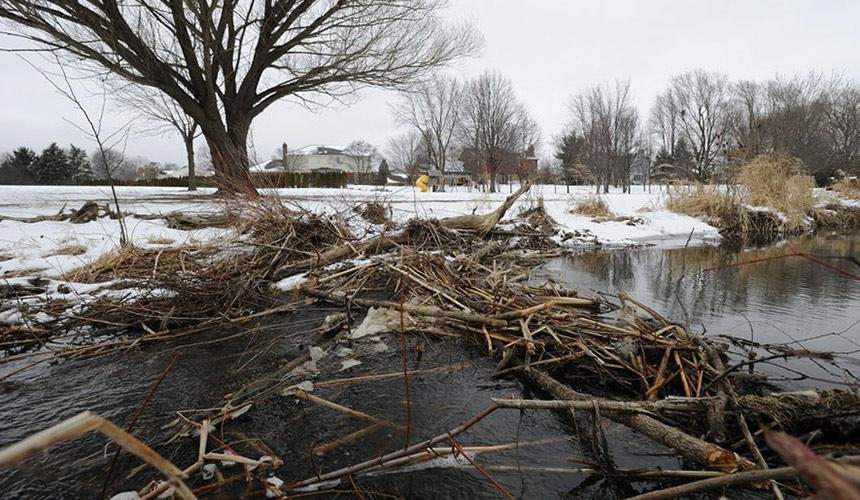
They also lay waste to ornamental and fruit trees. This mayhem results in a "nuisance beaver" removal campaign, designed to kill all the beavers, then blow up their dam with dynamite. What could go wrong?
Trapping Beaver
Beaver trapping is most successful when the trapper truly understands what makes this animal tick. It is first and foremost a natural engineer of its environment, creating a place to live and multiply, under all conditions and weather. The trapper must get his set right the first time, because a mistake results in an "educated" beaver, which is near impossible to catch. The "conibear" body grip trap is an inexpensive (less than twenty dollars,) easy to use lethal device. It is normally set under water in a beaver "run," so it is generally safe from children, pets and other land creatures.
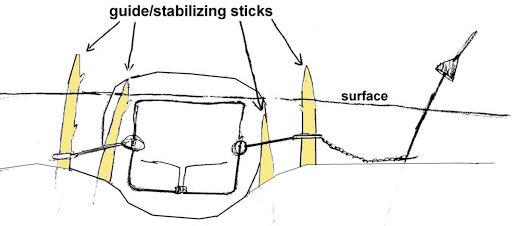
The cable snare is another inexpensive (less than two dollars,) device used to capture beaver alive. The snare is a non-lethal device used in the same kind of sets as the body grip trap, with the beaver held around the body until the trapper gets there. Another non-lethal trap is the suitcase style live trap.
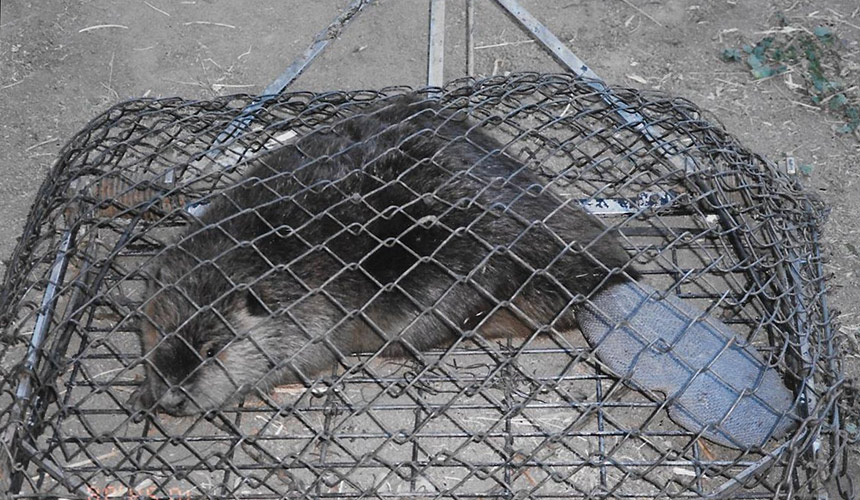
This opens and closes like a clam shell, a very large clam shell. It is an expensive (four hundred dollars) specialty trap used by researchers and nuisance wildlife control operators. Now what does one do with a large, angry, dangerous rodent......one that cuts down big trees with it's large, chisel-like incisors? How does the good hearted trapper handle this creature safely, and get it relocated without getting bit? Here is an example of the damage done to a dog by beaver incisors. The first time moving a large beaver is a "learn as you go" kind of thing. Here is the true account of one such "first time." Two trappers caught a large beaver in a cage trap and were instructed by Fish and Game to relocate it to a remote section of a public lake. At the release spot there were a few people fishing, who stopped to watch the impending spectacle. The trappers pointed the cage door in the direction of the lake, sixty feet away, then opened the door releasing the beaver. Instead of going to the water, the angry beaver started chasing the trappers around the truck, to the amusement of the fishermen. How do you tell a beaver is angry? They will hiss at you.
Beaver are graceful, swift swimmers, but on land are awkward and slow. It was not too difficult for the trappers to stay ahead. Finally they tired of the game, and hopped into the bed of the truck. The beaver did not lose a beat but headed straight towards the fishermen, who stopped laughing and ran away. The beaver finally waddled to swim into his new home. In the case of a beaver who has been "educated" by a sloppy trapper, it will never go into a conventional set. The options are to try and trick the animal, which can be frustrating, or learn when it comes out of its den. This may be early morning, or from late afternoon to dark. A trail camera comes in handy. The other piece of equipment needed is an accurate rifle, and night vision optics for after dark. A sound suppressor is required where shot noise might be a problem. We always advised local law enforcement when shooting might be needed.
The final piece to solving the nuisance beaver problem is preventative and does not involve killing or dynamiting. It does require the labor needed to build a "pond levelling" device. This is made up of a sixteen foot section of six inch round PVC pipe installed on the pond side of the beaver dam at the level desired. The inlet to the pipe is protected with a weld wire cage, and the outlet is disguised with sticks and mud. This also works to keep culverts clear. Complete plans are available from Clemson University, Department of Agriculture, Fisheries and Wildlife, G08 Lehotsky Hall, Clemson, SC, 29634.
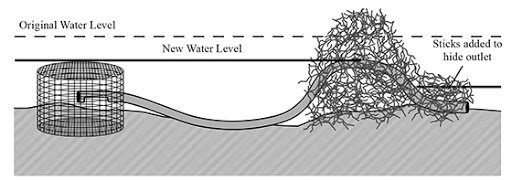
Where there are trees that need to be protected, a wire cage should be installed.
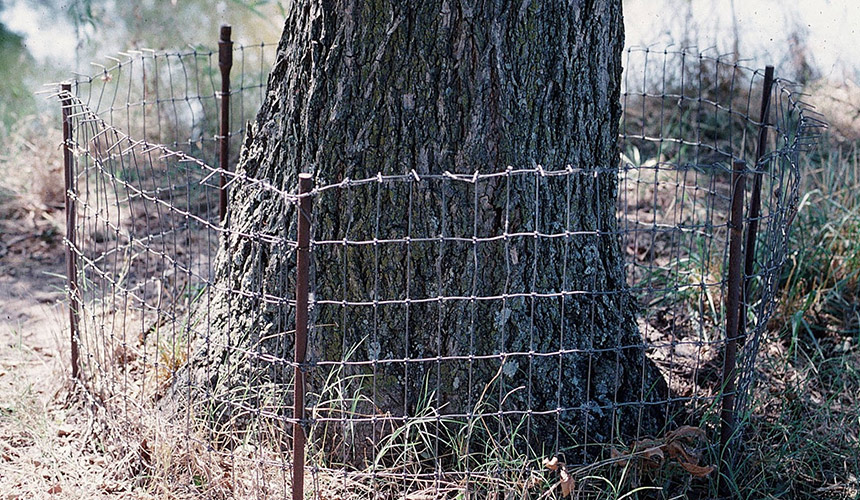
This site is intended to provide beaver education and information, so that you can make an informed decision if you need to deal with a beaver problem. This site provides many beaver control articles and strategies, if you wish to attempt to solve the problem yourself. If you are unable to do so, which is likely with many cases of beaver removal, please go to the home page and click the USA map, where I have wildlife removal experts listed in over 500 cites and towns, who can properly help you with your nuisance beaver.

















